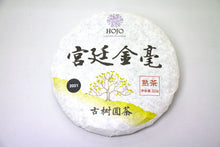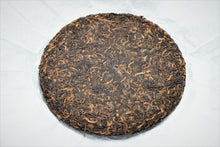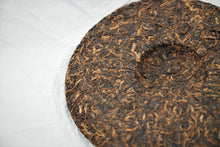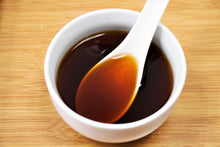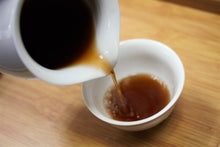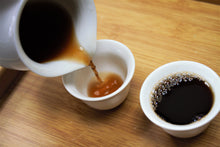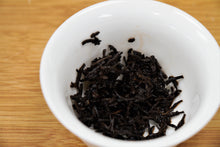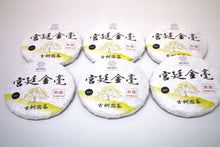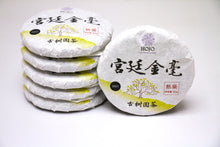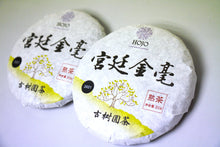
In Chinese, "Gong Ting" translates to "imperial," while "Jin Hao" means "golden hair."
"Gong Ting Jin Hao" is highly esteemed as the highest grade of ripe pu-erh tea, primarily due to its abundance of tea buds. Its rarity stems from the meticulous tea-making process, where each twig of tea leaf collected contains merely 3 to 4 tea leaves accompanied by just 1 tea bud. This prevalence of tea buds imparts a captivating golden hue to the brew. Moreover, the tea liquor exudes a velvety smoothness, offering a delightful drinking experience with absolutely no astringency or bitterness.
It has matured beautifully, acquiring a dried fruity note reminiscent of dates or figs, accompanied by a subtle drinking sensation akin to raw chocolate. It is a delightful tea that can be enjoyed at any time of the day or paired excellently with a savory meal or dessert.Two Different Types of Ripe Pu-erh
Before we go into details about the Gong Ting Jin Hao ripe pu-erh tea, I would like to explain about two different types of ripe pu-erh in terms of the shape of tealeaf.
- The mao-cha (the crude tea) is compressed as it is
- The mao-cha is graded and different segments are selectively introduced
For example, let's consider the mini tou cha, which possesses small and consistent leaf size. This characteristic is a result of the grading process. After fermentation, ripe pu-erh tea undergoes sifting and grading, with the finer tea leaves typically earmarked for the production of mini tuo cha. Regrettably, there is a common misconception among some people who view these small leaves as an indicator of inferior quality, assuming they are broken or cut leaves. However, this is a misunderstanding or myth.
Following the fermentation process, the same batch of pu-erh tea leaves is graded, and the finer segments are gathered specifically for the creation of mini tuo cha. As a consequence, the quality of mini tuo cha is on par with the raw material used for the production of the same batch of ripe pu-erh tea. In essence, it does not represent inferior quality when compared to the larger leaves graded from the same batch.
Left: Mao Cha and Right: Graded Tea
Cup Characteristics of Gong Ting Pu-erh
The unique components within tea buds deliver an exceptionally refined and pleasant drinking experience. It feels akin to snow melting delicately on the palate, imparting a sense of pure elegance. The flavor is remarkably gentle, delicate, and smooth, reminiscent of the indulgent richness of fine, raw chocolate.


A well-crafted, high-quality ripe pu-erh tea exhibits a tea liquor that is rich in color yet clear, with no cloudiness or bitterness. When stored under suitable conditions, it develops a dried fruit aroma reminiscent of dates, without any musty or moldy notes.

Ripe Pu-erh Tea Grades Reflect Character, While Quality Is Defined by Raw Materials
As I mentioned earlier, ripe pu-erh tea is categorized into different grades, each with a unique price range. However, it’s important to note that these grades only apply within the same type of tea leaves and do not directly indicate the fundamental quality of the tea itself. For example, if there were 100 different types of pu-erh tea, each would have its own Gong Ting grade tea within its category.
The quality among these Gong Ting pu-erh teas can vary greatly, largely based on the quality of the raw materials used. Therefore, the first priority should be to find high-quality tea before considering its grade. Only then can we fully appreciate and discuss the finer distinctions in the grading process.
Grown in a Sustainable Ecological Environment
This Gong Ting Jin Hao tea is made from old tea trees grown with natural farming methods as part of the surrounding ecology, without fertilizers or pesticides.
To my knowledge, most ripe pu-erh tea comes from garden teas, where modern agricultural practices provide exceptional care. It is rare, however, to find ripe pu-erh tea made from old tea trees grown in their natural ecological environment. Typically, tea leaves from such valuable trees are processed into raw pu-erh tea, where they fetch a higher price. This is why old-tree teas are rarely used for ripe pu-erh production.
In contrast, garden tea usually has a lighter aftertaste, with flavors that dissipate relatively quickly. On the other hand, tea grown naturally produces a robust, enduring aftertaste due to its slower growth, as it receives no fertilizers or pesticides. The tea also accumulates a wealth of beneficial compounds, like polyphenols and minerals from the soil, resulting in a richer, thicker taste and a deeply satisfying drinking experience.











